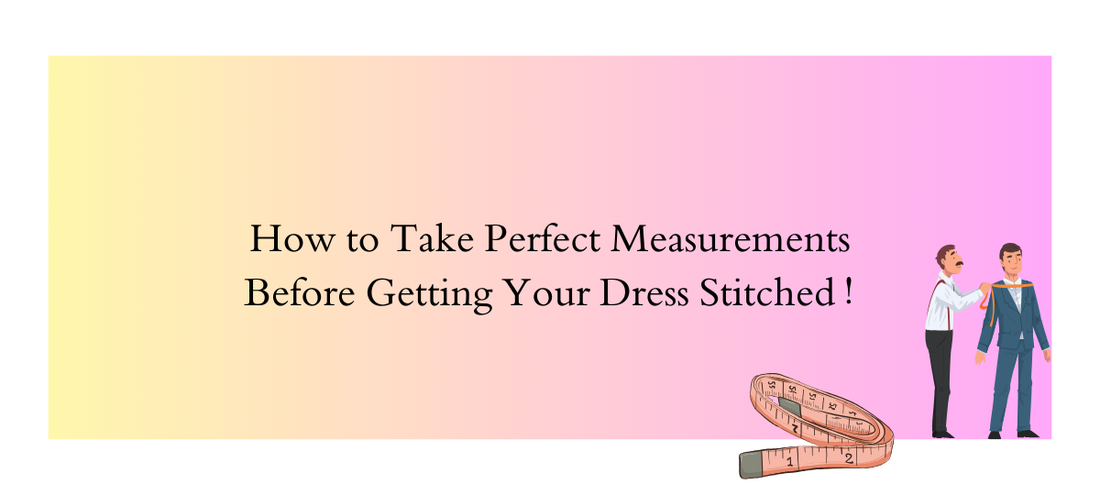
📏✨ How to Take Perfect Measurements Before Getting Your Dress Stitched
Share
In the world of ethnic fashion, nothing beats the elegance of a well-tailored outfit made from beautiful unstitched dress materials. Be it a Banarasi silk kurta set, a Chanderi silk suit with Zardosi embroidery, or a breezy cotton silk kurti with Kantha work, the magic lies in the fit.
At our ethnic brand, we often hear from customers how an ill-fitting suit can ruin the charm of even the most luxurious fabrics. That’s why taking accurate body measurements before handing your dress material to your local tailor is key.
Here’s a simple, step-by-step guide to help you get it right — so your next custom-stitched outfit feels like it was made just for you (because it was!).
📌 Why Proper Measurements Matter
The true beauty of unstitched dress materials lies in their versatility. You can turn them into straight-cut suits, Anarkalis, A-line kurtas, or trendy Indo-western pieces — but only if you start with correct measurements.
A well-measured outfit:
-
Enhances your body shape
-
Makes luxurious fabrics like Banarasi silk, Chanderi silk, and linen drape perfectly
-
Highlights embroidery like Kantha, Zardosi, and Jaipuri block prints beautifully
-
Eliminates uncomfortable tightness or awkward loose spots
📌 Essentials You’ll Need
-
A soft measuring tape
-
A fitted garment you already own for reference (optional)
-
A notebook or phone notes to record the numbers
-
A friend’s help (for tricky measurements like back width or shoulder length)
Pro Tip: Always take measurements in front of a mirror, standing naturally — no stomach sucking in or shoulders stiffened.
📌 Important Measurements to Take
1️⃣ Bust
Wrap the measuring tape around the fullest part of your bust. Keep it snug but not tight. This is especially crucial for fitted cotton silk kurtis and Chanderi Anarkalis.
2️⃣ Waist
Measure around the narrowest part of your waistline. A well-fitted waist makes A-line suits and straight-cut kurtas look sharper.
3️⃣ Hip
Wrap the tape around the fullest part of your hips. Important for outfits like floor-length Banarasi suits and straight pants.
4️⃣ Shoulder Width
Measure from one shoulder bone to the other. This defines how the sleeves and neckline of your Kantha work kurta or organza suit will sit.
5️⃣ Sleeve Length
Decide whether you want full sleeves, ¾th, or elbow-length, and measure from shoulder tip to desired length.
6️⃣ Armhole
Wrap the tape around the fullest part of your upper arm, with some ease for comfort. Crucial for Zardosi embroidered sleeves.
7️⃣ Kurta Length
Measure from the shoulder top to where you want the kurta to end — knee, calf, or floor-length.
8️⃣ Bottom Length
For salwars, palazzos, or pants, measure from your waist to ankle (or floor, for shararas and lehengas).
📌 Additional Measurements (If Needed)
-
Neck Depth (Front & Back)
-
Wrist circumference for fitted sleeves
-
Knee or calf circumference for churidars or cigarette pants
📌 Tips for the Perfect Fit
✅ Always add ½ inch to 1 inch margin for comfort, especially for cotton silk and linen fabrics, which may slightly shrink after the first wash.
✅ If your fabric has heavy embroidery like Zardosi or beaded work, allow extra room for stitching and lining.
✅ For Banarasi silk and organza, avoid extremely tight fits — these fabrics drape better with a little ease.
✅ Share your measurements and desired outfit style clearly with your tailor. A good tailor will appreciate precise numbers.
📌 Final Thoughts — Fit is Fashion
The perfect ethnic outfit isn’t just about luxurious fabrics like Chanderi silk, Banarasi silk, and pure linen, or beautiful embellishments like Kantha work and Jaipuri prints — it’s about how it sits on you.
By following this simple measurement guide, you ensure that your custom-stitched suit not only looks stunning but also feels effortlessly comfortable.
At our ethnic brand, we believe that luxury lies in the details — and a perfect fit is the finest detail of all.
